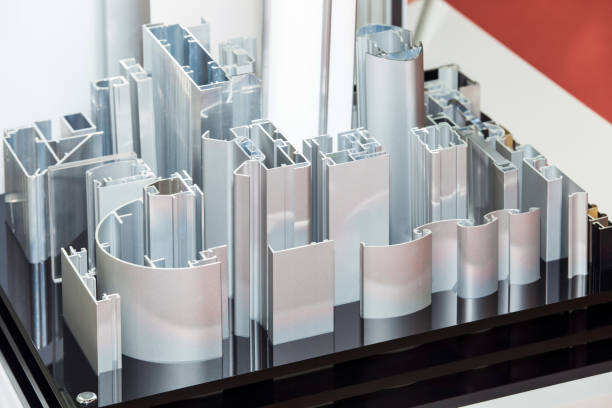Understanding the Custom Aluminum Extrusion Process
The Aluminum Extrusion Process Explained
Custom aluminum extrusion works by taking solid aluminum billets and shaping them into all sorts of complicated forms using heat and pressure. First thing's first, those billets get warmed up until they're soft enough to work with but still solid. When ready, the softened metal gets forced through specially made dies which give it whatever shape we need for the final product. What makes this method so valuable in aluminum fabrication is how versatile it really is. We can make everything from simple bars to intricate components that fit exact specifications for different industries and applications.
In aluminum extrusion work, temperature and pressure matter a lot during production runs. Getting the heat right keeps the metal soft enough to work with while still holding its strength properties intact. When it comes to pressure settings, manufacturers need to get this just right so the molten aluminum actually takes on the exact shape of whatever die they're using. Finding that sweet spot between these two factors makes all the difference when making custom aluminum components. Even small mistakes here can lead to inconsistent products or quality issues down the line, which nobody wants when working on precision parts for industrial applications.
Aluminum extrusion relies on various die types, each offering distinct benefits depending on what needs to be produced. Direct extrusion keeps the dies fixed in place while pushing the heated billet through them, making it ideal for simple shapes like tubes or rods. Indirect extrusion works differently by moving the die around the billet, allowing manufacturers to create intricate profiles with smoother surfaces. These methods aren't just technical variations they actually determine whether a product will have basic functionality or advanced features. For companies needing specialized components, understanding these differences becomes crucial when balancing cost against performance requirements in their manufacturing processes.
Choosing the Right Alloy for Unique Projects
Picking the correct aluminum alloy makes all the difference for any custom fabrication work. Different alloys bring their own strengths to the table regarding durability, how much they weigh, and how well they stand up against things like rust and weather damage. What gets chosen really affects how long something lasts and works properly once it's built. That's why matching the alloy specs to what the actual job needs becomes so important for anyone working on specialized projects.
When talking about aluminum extrusions, most manufacturers reach for either 6061 or 6063 series alloys. The 6061 type stands out because it packs serious strength without sacrificing too much on other fronts. That's why we see it all over places where things need to hold up under stress, like frames for outdoor structures or parts that must withstand harsh environments. Its combination of toughness against rust and ability to be shaped into different forms makes it pretty versatile stuff. On the flip side, 6063 has become something of a favorite among architects and designers who care about how things look as much as they do about function. This alloy bends nicely during processing and leaves behind surfaces that don't require much finishing work afterwards. For anyone working on custom projects involving aluminum, knowing when to pick one over the other can make a world of difference in both performance and aesthetics down the road.
Choosing the right alloy affects not just how something looks but also what kind of finish and heat treatment it needs, which ultimately changes how well it works and how it appears at the end. Take anodizing for example some metals take this process much better than others, making them last longer against rust while looking nicer too. Each metal has its own traits that make certain finishes work better, so picking the correct material really matters if someone wants their aluminum parts to look good and perform properly after fabrication is complete.
Applications of Custom Aluminum Profiles in Unique Projects
Architectural and Construction Innovations
Aluminum profiles made to order are changing how we think about buildings today because they combine light weight with strength and come in all sorts of shapes and finishes. We see this happening everywhere now in buildings where aluminum extrusions form important parts of the structure like those big windows and exterior walls. Architects love working with these materials since they give so much freedom when designing buildings that look good while standing up to wear and tear over time. Take any modern skyscraper or fancy building frontage and there's probably some custom cut aluminum behind those clean lines and bold statements.
Transportation and Automotive Solutions
Aluminum extrusions have become really important in transportation because they help vehicles burn less fuel and weigh less overall. Car makers use custom aluminum shapes all over the place these days - think frames, cooling systems, even parts of the car body itself. This lets them build cars that are both lighter and work better on the road. Another big plus for aluminum is how easy it is to recycle again and again. As environmental concerns grow stronger across the industry, this becomes a major selling point. When auto companies start using more aluminum in their designs, they're not just being green minded; they also get real world advantages since aluminum packs a lot of strength without adding much weight at all.
Specialized Industrial and Consumer Uses
Aluminum products made to order find their way into all sorts of industrial settings these days. We're talking about things like brackets, frames and support structures across various engineering fields and manufacturing operations. When it comes to everyday items too, appliances and electronic devices really get a boost from specially crafted aluminum components. These parts not only make the products work better but also look nicer overall. More people are asking for aluminum in their consumer goods lately, which points to something bigger happening in the market. Manufacturers seem to be gravitating toward lighter weight materials that still hold up well while allowing creative design options. This change isn't just about saving money either. Companies are actually redesigning products with custom extruded aluminum shapes specifically to create better experiences for users who want both quality and style in what they buy.
Precision Engineering for Complex Designs
Aluminum extrusions stand out as an excellent way to manufacture detailed designs according to very specific requirements. These extrusions open up numerous options across different sectors, from creating specialized aluminum profiles used in building construction to making highly accurate components needed for industrial equipment. What makes extrusion so effective is its ability to produce complicated forms while maintaining strict dimensional accuracy, which means parts perform reliably without compromising strength. Recent improvements in computer numerical control (CNC) technology have taken this even further, allowing manufacturers to achieve levels of detail previously thought unattainable through traditional fabrication techniques. With CNC machines able to cut away material with incredible precision, aluminum continues to gain ground against competitors when it comes to producing bespoke parts. Industries ranging from aerospace to medical device manufacturing increasingly turn to aluminum extrusions because they deliver both versatility and exceptional quality in custom applications.
Sustainability and Corrosion Resistance
Aluminum really shines when it comes to being green and sustainable stuff, mainly because we can recycle it completely without any quality loss. The Aluminum Association reports something pretty impressive: around 75% of all aluminum made so far is still being used somewhere, and in industries such as cars and buildings, recycling rates hit over 90%. That kind of ongoing recyclability fits right into what companies are trying to achieve with their sustainability targets while cutting down on carbon footprints for things made with aluminum. Another big plus for aluminum is how resistant it is to rust and decay. Products made from aluminum last much longer when put through tough conditions. There's actually a thin oxide film that forms naturally on aluminum surfaces which acts as protection against corrosion. This makes aluminum great for stuff placed outside or near water like boats and coastal structures. Longer lasting products mean less frequent replacements, which cuts down both repair expenses and overall environmental effects in the long run.
Cost-Effective Material Optimization
Custom aluminum extrusion stands out because it really cuts down on wasted materials, which saves money in the long run. When companies design profiles exactly what they need for each specific job, there's just not as much scrap metal left over compared to other approaches. Take it against old school methods such as die casting or injection molding, and aluminum extrusion typically comes with much cheaper setup costs upfront. That makes all the difference when someone needs something special but doesn't want to spend a fortune on tools just for a few pieces. Once the die gets made though, production actually speeds up quite a bit. The process works well whether making hundreds or just dozens at a time. Because of this flexibility, manufacturers can ramp up or scale back based on actual orders without breaking the bank. For shops trying to stretch every dollar while still getting quality parts, aluminum extrusion often becomes the go to choice.
Designing Custom Aluminum Profiles: From Concept to Fabrication
Tailored Finishes and Functional Features
When it comes to making custom aluminum profiles, what we're really doing is turning ideas into real products through customized finishes and added functions. There are several ways to finish aluminum these days. Anodizing works great for fighting corrosion and gives access to lots of colors. Powder coating beats regular paint hands down when it comes to lasting longer and looking better over time. These treatments do more than just make things last longer they actually give aluminum products that edge they need to compete against others on store shelves. Adding special features like custom channels or unusual shapes makes products work better for their intended purpose, opening up all sorts of possibilities for creative designs. Take a look at what companies in the car industry or tech world have done recently. They've used these specialized approaches to stand apart from competitors who offer generic designs. The difference between good and great often comes down to those little touches that make a product truly unique.
Collaborating with Extrusion Specialists
Getting good results from custom aluminum profiles starts with working closely with seasoned extrusion experts. These pros bring real world know-how to handle all those tricky parts of designing and making prototypes so each profile actually works for what the project needs. When designers and fabricators talk regularly during development, they can tweak things as they go along. This back and forth makes sure the final product performs well while still being something that can actually be manufactured efficiently. Good communication throughout the whole process keeps everyone on the same page and cuts down on misunderstandings that slow things down. Projects that use this kind of ongoing feedback generally run smoother too because they tap into what these specialists know from years in the field. The end result? Less wasted time and money when it comes to getting those finished products out the door.

